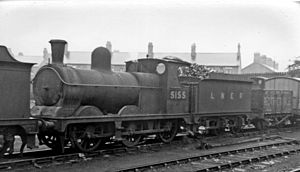GCR Class 9D
| GCR Class 9 LNER Class J10 | |||||||||||||||||||||||||||||||||||||||||
|---|---|---|---|---|---|---|---|---|---|---|---|---|---|---|---|---|---|---|---|---|---|---|---|---|---|---|---|---|---|---|---|---|---|---|---|---|---|---|---|---|---|
 No. 5155 at Northwich Locomotive Depot 1947 | |||||||||||||||||||||||||||||||||||||||||
| |||||||||||||||||||||||||||||||||||||||||
| |||||||||||||||||||||||||||||||||||||||||
| |||||||||||||||||||||||||||||||||||||||||
| |||||||||||||||||||||||||||||||||||||||||
The GCR Classes 9D, 9H and 9M (LNER Class J10) were a class of 124 0-6-0 Steam locomotives designed by Harry Pollitt for freight work on the Manchester, Sheffield and Lincolnshire Railway (MS&LR) later renamed Great Central Railway (GCR).
Career[]
Great Central Railway[]
During World War I, seven of them were loaned to the Caledonian Railway. They were modified to have shorter chimneys. In 1921, 10 were sent to Barrow-in-Furness to undergo repairs.[1]
London and North Eastern Railway[]
The locomotives passed to the London and North Eastern Railway (LNER) in 1923. The LNER classified them as J10 with sub-classes J10/1 to J10/6 because of detail differences.[2] Withdrawals began in 1933, but were rather slow.[3]
British Railways[]
Some 78 locomotives survived into British Railways (BR) ownership in 1948 as follows:
BR numbers were 65126–65209 (with gaps). In the 1950s, some of them were sent to work at sheds once belonged to the LMS, the L&YR, and the LNWR. They were also reported to be popular with ex-LMS employees. All locomotives had been withdrawn by 1961 with the last one in service No. 65157 going in August 1961. None were preserved.[7]
References[]
- ^ "The Parker & Pollitt J10 (GCR Classes 9D & 9H) 0-6-0 Locomotives". LNER Encyclopedia. Retrieved 5 December 2020.
- ^ "The Parker & Pollitt J10 (GCR Classes 9D & 9HI) 0-6-0 Locomotives". Lner.info. Retrieved 28 February 2012.
- ^ "The Parker & Pollitt J10 (GCR Classes 9D & 9H) 0-6-0 Locomotives". LNER Encyclopedia. Retrieved 5 December 2020.
- ^ "Rail UK Steam Loco Class Information". Railuk.info. Retrieved 28 February 2012.
- ^ "Rail UK Steam Loco Class Information". Railuk.info. Retrieved 28 February 2012.
- ^ "Rail UK Steam Loco Class Information". Railuk.info. Retrieved 28 February 2012.
- ^ "The Parker & Pollitt J10 (GCR Classes 9D & 9H) 0-6-0 Locomotives". LNER Encyclopedia. Retrieved 5 December 2020.
- Fry, E. V., ed. (September 1966). Locomotives of the L.N.E.R., Part 5: Tender Engines—Classes J1 to J37. Kenilworth: RCTS. pp. 53–62. ISBN 0-901115-12-6.
- Great Central Railway locomotives
- 0-6-0 locomotives
- Railway locomotives introduced in 1892
- Kitson locomotives
- Beyer, Peacock locomotives
- Scrapped locomotives
- Freight locomotives
- Standard gauge steam locomotives of Great Britain
- England steam locomotive stubs